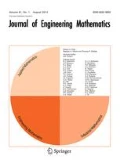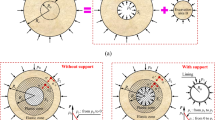Abstract
For stability analysis of shallow shield tunnels in cohesive-frictional (clayey–sandy) soils, an analytical method of continuous upper bound limit analysis is developed to determine the most critical slip line position and the minimum required tunnel support pressure. The ground displacement field due to composite volume loss is calculated using a complex variable solution, and the optimization problem is solved by employing the particle swarm optimization technique. Energy dissipation at the potential slip boundary, which is determined through a system of tracking schemes, and in the corresponding potential plastic zone is taken into account. Example calculations are carried out to verify the proposed method via finite element simulations and comparisons with solutions from existing methods, and to study the effects of soil strength properties and tunnel size and depth. The results show that both the internal friction and the cohesion of the surrounding soil may help reduce the range of the potential collapse zone and the magnitude of the necessary support pressure. This study represents the first attempt to deal with cohesive-frictional soils via an analytical and continuous approach, and the developed method can be extended for various tunnel and other geotechnical stability problems involving cohesive-frictional soils.














Similar content being viewed by others
References
Davis EH, Gunn MJ, Mair RJ et al (1980) The stability of shallow tunnels and underground openings in cohesive material. Géotechnique 30(30):397–416
Leca E, Dormieux L (1990) Upper and lower bound solutions for the face stability of shallow circular tunnels in frictional material. Géotechnique 40(4):581–606
Mollon G, Dias D, Soubra AH (2011) Rotational failure mechanisms for the face stability analysis of tunnels driven by a pressurized shield. Int J Numer Anal Met. 35(12):1363–1388
Yamamoto K, Lyamin AV, Wilson DW, Sloan SW, Abbo AJ (2011) Stability of a circular tunnel in cohesive-frictional soil subjected to surcharge loading. Comput Geotech 38(4):504–514
Sloan SW, Assadi A (1993) Stability of shallow tunnels in soft ground. Predictive soil mechanics. In: Houlsby GT, Schofield AN (eds) Proceedings of the Wroth Memorial Symposium. Thomas Telford, London pp 644–663
Sahoo JP, Kumar J (2013) Stability of long unsupported twin circular tunnels in soils. Tunn Undergr Sp Tech 38:326–335
Sahoo JP, Kumar J (2014) Stability of a circular tunnel in presence of pseudostatic seismic body forces. Tunn Undergr Sp Tech 42:264–276
Sahoo JP, Kumar J (2018) Required lining pressure for the stability of twin circular tunnels in soils. Int J Geomech 18(7):04018069.1-15
Jang G (1998) Limit analysis of the stability of shallow tunnels in soft ground. China Civil Eng J 31(5):65–72 (in Chinese)
Yang F, Yang J, Zhao L, Zhang J (2015) Finite element upper bound limit analysis and application for the stability of the surrounding rocks of tunnels. Academic Press, Beijing (in Chinese)
Smith C, Gilbert M (2007) Application of discontinuity layout optimization to plane plasticity problems. Proc R Soc A 463:2461–2484
Zhang Y, Zhuang X, Lackner R (2018) Stability analysis of shotcrete supported crown of NATM tunnels with discontinuity layout optimization. Int J Number Anal Met 42(11):1199–1216
Osman AS, Mair RJ, Bolton MD (2006) On the kinematics of 2D tunnel collapse in undrained clay. Géotechnique 56(9):585–595
Osman AS, Bolton MD, Mair RJ (2006) Predicting 2D ground movements around tunnels in undrained clay. Géotechnique 56(9):597–604
Klar A, Osman AS, Bolton M (2007) 2D and 3D upper bound solutions for tunnel excavation using ‘elastic’ flow field. Int J Numer Anal Met 31(12):1367–1374
Mollon G, Dias D, Soubra AH (2013) Continuous velocity fields for collapse and blowout of a pressurized tunnel face in purely cohesive soil. Int J Numer Anal Met 37(13):2061–2083
Klar A, Klein B (2014) Energy-based volume loss prediction for tunnel face advancement in clays. Géotechnique 64(10):776–786
Xiang Y, Song W (2017) Upper bound limit analysis of shield tunnel stability in undrained clays using complex variable solutions for different ground loss scenarios. Int J Geomech 17(9):04017057.1-8
Song W (2020) A continuous upper bound limit analysis for the transverse stability of shallow shield tunneling in undrained clays. Eur J Environ Civil Eng 24(3):401–422
Chen WF (1975) Limit analysis and soil plasticity. Elsevier, Amsterdam
Sagaseta C (1998) On the role of analytical solutions for the evaluation of soil deformation around tunnels. In: Cividini A (ed) Application of numerical methods to geotechnical problems. Springer, Vienna, pp 3–24
Sloan SW (1989) Upper bound limit analysis using finite elements and linear programing. Int J Numer Anal Met 13(3):263–282
Eberhart RC, Kennedy J (1995) A new optimizer using particles swarm theory. Proceedings of the 6th International Symposium on Micro Machine and Human Science pp 39–43
Kennedy J, Eberhart R (1995) Particle swarm optimization. Proceedings of IEEE International Conference on Neural Networks. 1942–1948
Acknowledgements
This study was sponsored by the China National Key Basic Research and Development Project (973 Project) under Grant No. 2015CB057800.
Author information
Authors and Affiliations
Corresponding author
Additional information
Publisher's Note
Springer Nature remains neutral with regard to jurisdictional claims in published maps and institutional affiliations.
Rights and permissions
About this article
Cite this article
Song, W., Xiang, Y. An analytical method of continuous upper bound limit analysis for the stability of shallow shield tunnels in cohesive-frictional soils. J Eng Math 122, 101–116 (2020). https://doi.org/10.1007/s10665-020-10050-x
Received:
Accepted:
Published:
Issue Date:
DOI: https://doi.org/10.1007/s10665-020-10050-x




